NICT has been regularly observing the ionospheric variations over Japan using the NICT’s ionosonde network. NICT also has been monitoring ionospheric total electron content (TEC) in the collaboration with Kyoto University and Nagoya University using the GPS receiver network, GEONET, operated by the Geospatial Information Authority of Japan (GSI). In these ionospheric observations, concentric waves propagating away from the vicinity of epicenter were detected in the ionosphere at around 300 km altitude from about 7 minutes to several hours after the 2011 Tohoku earthquake off the Pacific coast of northern Honshu on March 11 (See Figure 1).
Home > Press Release > Concentric waves appear at 300 km altitude after the 2011 Tohoku earthquake
Atmospheric waves reach ionosphere
The National Institute of Information and Communications Technology (NICT, President: Dr. Hideo Miyahara) has observed concentric waves propagating away from the vicinity of epicenter in the ionosphere at around 300 km altitude from about 7 minutes to several hours after the 2011 Tohoku earthquake on March 11. These ionospheric waves were detected using the GPS receiver network and the NICT’s radio observation network in Japan. It is considered that the atmospheric waves were excited at sea surface in the vicinity of epicenter and propagated up to the ionosphere.
It is the first time to observe all the details of such coseismic atmospheric waves following a large earthquake by wide-coverage dense ionospheric observation. This observational result is important not only to reveal the relationship between the ionosphere and the lower atmosphere, but also to apply the ionospheric observations to monitor tsunami in a wide area.
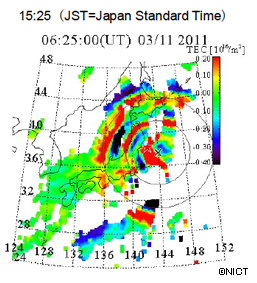
According to the GPS-TEC observation, concentric waves in the ionosphere began to appear about 7 minutes after the earthquake onset at 14:46:23 JST (05:46:23 UT) near the epicenter (38.322 deg N, 142.369 deg E, according to the U.S. Geological Survey) (See Figure 2). The center of these ionospheric concentric structures, termed the “ionospheric epicenter”, was located about 170 km from the epicenter in the southeast direction. The ionospheric epicenter was closer to the Japan trench than the epicenter and consistent with estimated areas of the tsunami source. These concentric waves appeared in the western part of Japan until around 18:00 JST (09:00 UT).
According to the observation of ionospheric electron density altitude profiles using ionosondes, swept-frequency vertical sounding radars, irregular distortion of ionospheric echo trace was observed at virtual height of 200-300 km in Japan after the earthquake (See Figure 3). These irregular echo traces are considered to be caused by the modulation of ionospheric height at the real height of 150-250 km due to the atmospheric waves associated with the earthquake.
These observational results indicate that this great earthquake caused not only underground waves (seismic wave) and sea waves (tsunami) but also atmospheric waves which propagated upward in the atmosphere and reached the ionosphere (See Figure 4). Although some aspects of coseismic ionospheric waves were observed after great earthquakes such as the 2004 Sumatra earthquake and the 2010 Chile earthquake, it is the first time to detect all the details of post-seismic ionospheric disturbances by high-resolution and wide-coverage ionospheric observations.
This study is important not only to reveal the relationship between the ionosphere and the lower atmosphere, but also to apply the ionospheric observations to monitor tsunami in a wide area. The details of this study will be presented at the American Geophysical Union (AGU) Fall Meeting 2011 (San Francisco, California, USA, 5-9 December). The first results of this study were published in the Journal “Earth, Planets and Space”.
Appendix
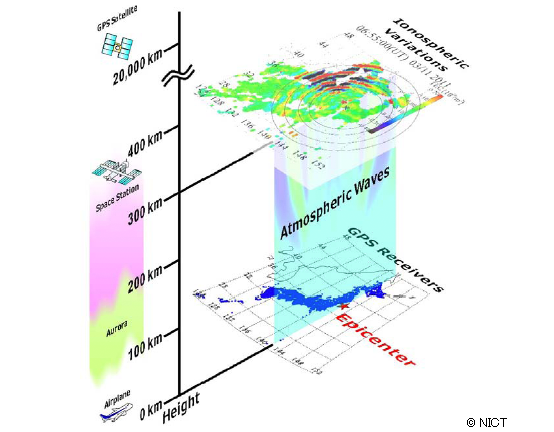
Ionospheric variations around 300 km altitude are observed using two-frequency GPS signals transmitted from satellites at about 20,000 km altitude and recorded by ground GPS receivers (GEONET, consisting of more than 1,200 stations). It is considered that the atmospheric waves were excited at sea surface in the vicinity of epicenter, propagated up to 300 km altitude, and generated the concentric structures in the ionosphere.
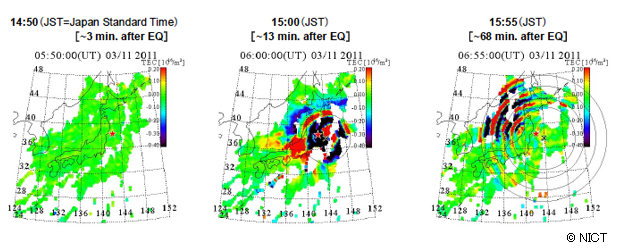
Two-dimensional maps of total electron content (TEC) variation derived using the data of GEONET, a dense GPS receiver network operated by GSI. The TEC data are detrended values derived by subtracting 10-minute running average of the data. The star and cross marks represent the epicenter and "ionospheric epicenter", respectively. Gray circles represent concentric circles with the ionospheric epicenter. The animation of TEC maps is available on the NICT website .
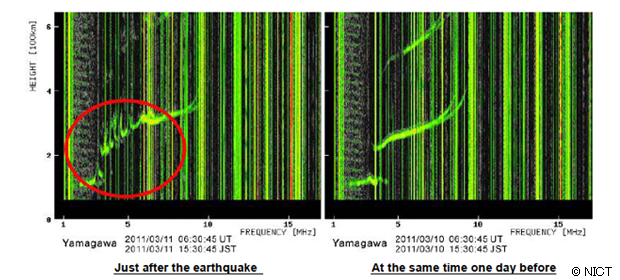
The horizontal and vertical axes of ionograms represent the frequency from 1 to 15 MHz and the virtual height from 0 to 600 km, respectively. The ionospheric echo traces in the ionograms correspond to the virtual height of the ionosphere. As indicated by the red circle, irregular distortion of echo trace was observed at virtual height of 200-300 km after the earthquake. The 200-300 km virtual height corresponds to the real height of 150-250 km. These irregular echo traces are considered to be caused by the modulation of ionospheric height due to the atmospheric waves associated with the earthquake.
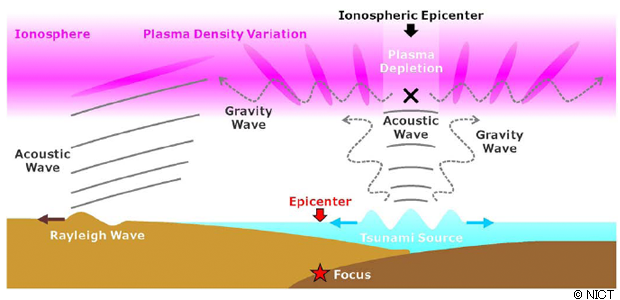
It is considered that the first ionospheric concentric wave with the propagation velocity of about 3.5 km/s was caused by the acoustic wave generated from the propagating Rayleigh wave. The second and following concentric waves would correspond to the atmospheric gravity waves (AGW) propagating in the ionosphere. The AGWs could be generated mainly at the lower ionosphere by the acoustic wave launched at the sea surface around the tsunami source.
Related Information
- The NICT website of “Ionospheric disturbances after the 2011 Tohoku earthquake”
(Animation of GPS-TEC observation is available) - AGU Fall Meeting 2011
(San Francisco, California, USA, 5-9 December) - “Earth, Planets and Space”,
Special Issue: First Results of the 2011 Off the Pacific Coast of Tohoku Earthquake
Technical Contact
Space Weather and Environment Informatics Laboratory
Applied Electromagnetic Research Institute
TEL:+81-42-327-5239
FAX:+81-42-327-6163
E-mail: 

















Media Contact
Public Relations Department
TEL:+81-42-327-6923
FAX:+81-42-327-7587
E-mail: 

























